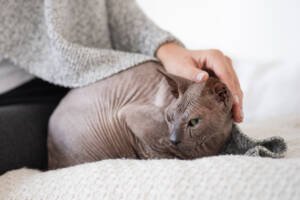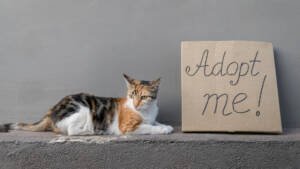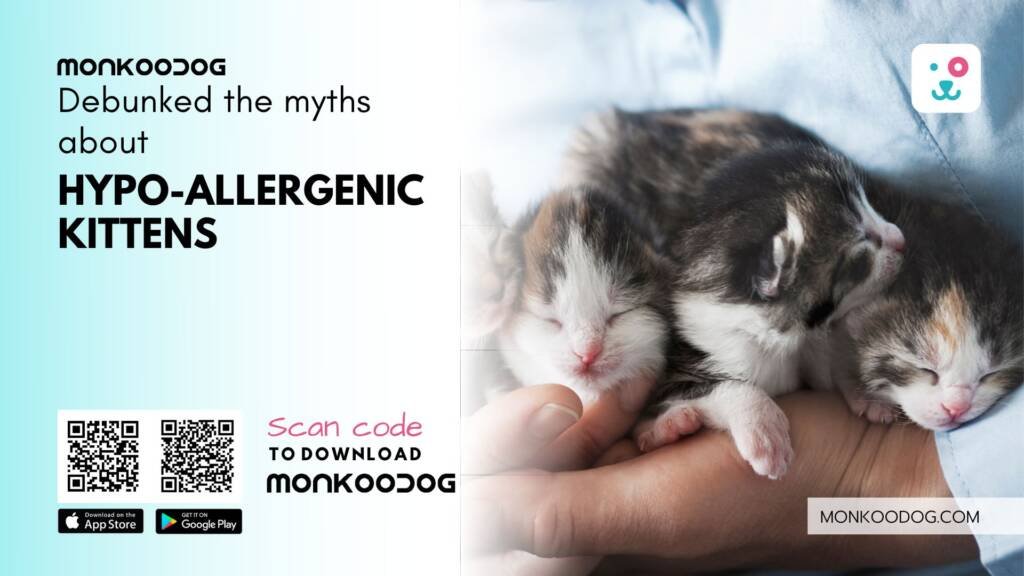Unraveling the Truth About Hypoallergenic Kittens
Are you one of the many cat lovers held back by allergies? The idea of hypoallergenic kittens might seem like a dream come true. But before you dive into looking for hypoallergenic kittens for sale, let’s clear up some common myths about Hypoallergenic Kittens. Understanding what “hypoallergenic” really means can help you make an informed decision and possibly lead you to your new furry friend with fewer sniffles.
Myth 1: Hypoallergenic Kittens are Completely Allergy-Free
Understanding Allergens
The term “hypoallergenic” suggests a lower likelihood of causing an allergic reaction, not a complete absence of allergens. Cats, including hypoallergenic kitten breeds can develop common cat allergies, produce several potential allergens, with proteins in their saliva, urine, and dander being the most common culprits. These allergens can attach to a cat’s fur and become airborne as the fur sheds.
The Reality
While no cat is entirely allergen-free, hypoallergenic cats produce fewer allergens than others or shed less, which can make a big difference for allergy sufferers. Breeds like the Siberian or the Balinese produce less of the Fel d 1 protein, the primary allergen found in cats, making them more suitable for people with mild allergies.
Myth 2: Only Hairless Cats are Hypoallergenic

Varieties of Hypoallergenic Cats
The common misconception that only hairless cats like the Sphynx are hypoallergenic often leads potential cat owners astray. While it’s true that hairless cats may appear to be a logical choice for reducing allergens, they can still produce significant amounts of allergens through their skin oils and saliva. It’s crucial to understand that the lack of hair doesn’t necessarily equate to a lack of allergens. Instead, allergen production varies significantly across different breeds and even individual cats.
Furthermore, several cat breeds feature unique coat types that contribute to a hypoallergenic nature without being hairless. Breeds such as the Siberian, despite having a moderately long coat, are known to produce less Fel d 1, the primary allergen found in cats. This makes them suitable for people with mild to moderate allergies, challenging the notion that effective hypoallergenic cats must be hairless.
Importance of Fur and Dander
When considering hypoallergenic cats, the type of fur and the amount of dander they produce are more significant factors than the mere presence of fur. Breeds with fine hair, such as the Russian Blue or the Cornish Rex, also fall into the hypoallergenic category. These breeds are known for their coats that either shed less overall or hold onto their dander more tightly, thus minimizing the spread of allergens in the environment.
The Russian Blue, for example, has a dense, fine coat that not only minimizes loose fur but also traps dander close to the skin. Similarly, the Cornish Rex, with its curly coat, tends to shed significantly less than typical short-haired breeds, reducing the amount of hair and dander that becomes airborne.
Understanding these dynamics can greatly aid in selecting a cat that aligns with the needs of allergy sufferers. By focusing on breeds that naturally produce fewer allergens or manage to keep their dander from becoming airborne, prospective pet owners can find a loving feline friend that fits well within their lifestyle without exacerbating allergies. This expanded view of what constitutes a hypoallergenic cat opens up many more options than solely considering hairless varieties, providing more opportunities for those sensitive to allergens to enjoy the companionship of a cat.
Myth 3: Hypoallergenic Cats Don’t Require Grooming

Grooming Needs of Hypoallergenic Cats
While hypoallergenic cats may produce fewer allergens, they still require regular grooming to manage shedding and dander. Regular baths and brushing can help reduce the presence of allergens in your home by removing dander-laden fur before it spreads.
Best Practices
Investing time in grooming your hypoallergenic kitten can not only reduce allergen levels but also serve as a bonding activity. Use grooming as an opportunity to check for signs of skin issues or allergies that your kitten might have, as even hypoallergenic breeds can be prone to dermatological issues.
Myth 4: Hypoallergenic Kittens Are More Expensive Than Other Cats
Cost Factors for Hypoallergenic Cats
While some hypoallergenic kitten breeds can be pricier due to their rarity or breeding costs, not all hypoallergenic options will break the bank. The price can vary widely based on factors like pedigree, availability, and whether you choose to adopt from a breeder or a rescue.
Understanding Pricing

Do a thorough research when looking into hypoallergenic kittens for sale. Sometimes, adopting from a shelter might lead you to a hypoallergenic kitten that needs a home, potentially reducing the cost significantly compared to purchasing from a specialty breeder.
Myth 5: Hypoallergenic Cats are Rare and Hard to Find
Finding a Hypoallergenic Kitten
One of biggest myths about hypoallergenic kittens is that these hypoallergenic breeds are less common, they are becoming more prevalent as breeders respond to increased demand. Resources like breed-specific rescues or breeders who focus on hypoallergenic traits are starting to become more accessible.
Breed Availability
Network with local vets, visit cat shows or connect with online forums dedicated to cat breeding to find reliable sources for hypoallergenic kittens. Patience and research can lead you to a reputable source, ensuring you bring home a healthy, hypoallergenic kitten.
Conclusion: Making an Informed Decision
Busting these myths about hypoallergenic kittens, not only helps in setting realistic expectations when adopting a hypoallergenic kitten but also prepares you for the responsibilities that come with owning one. Whether you suffer from allergies or simply prefer a cat that might reduce sneezing around the house, hypoallergenic kittens can make wonderful pets. They offer all the love and companionship of their more allergenic counterparts, with just a bit less of the sneeze-inducing fluff.
Ready to find your perfect, low-allergen feline friend? Remember, the key to a happy home with pets, whether hypoallergenic or not, is understanding their needs and knowing how to meet them. With this guide, you’re well on your way to becoming an informed and prepared cat owner, ready to enjoy the myriad joys a hypoallergenic kitten can bring into your life.





